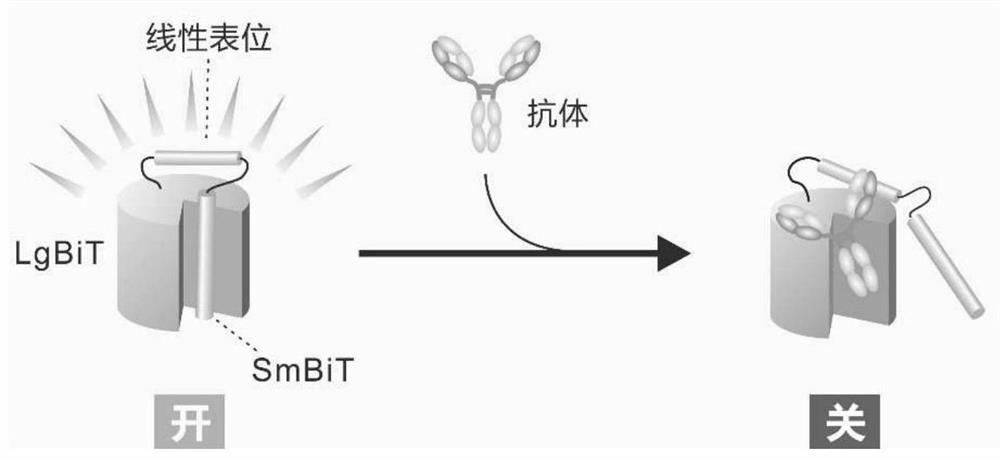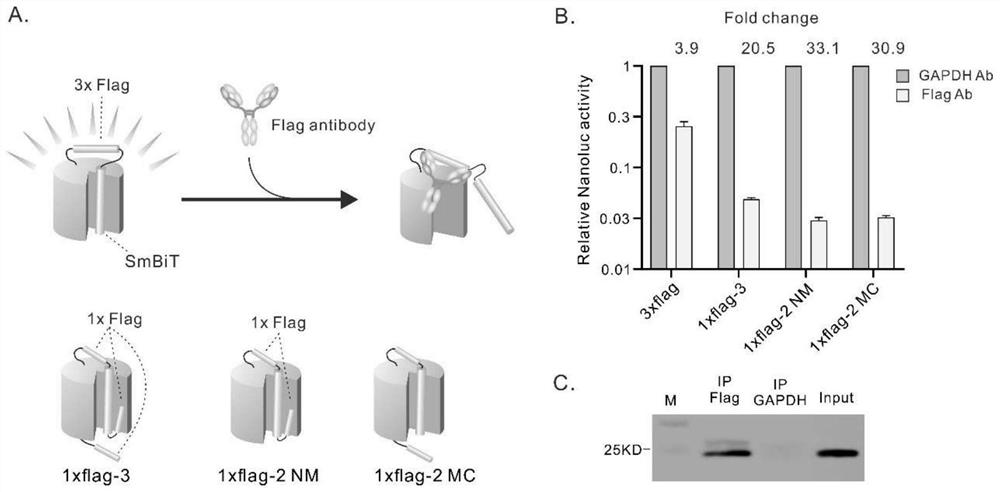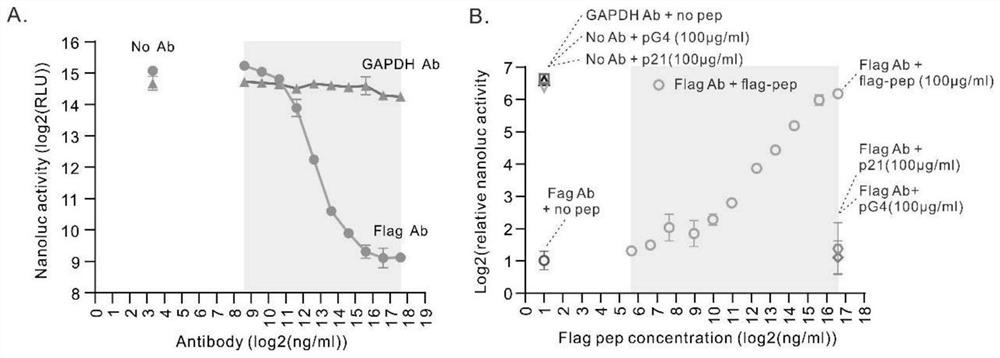Multifunctional protein molecule switch used for antibody detection
A molecular switch and protein molecular technology, applied in the field of protein detection, can solve the problems that have not yet been reported on Nanoluc luciferase detection antibody
- Summary
- Abstract
- Description
- Claims
- Application Information
AI Technical Summary
Problems solved by technology
Method used
Image
Examples
Embodiment 1
[0063] Example 1 A NanoSwitch molecular switch for Flag antibody detection
[0064] 1. Principle
[0065] This example takes Flag antibody as an example to demonstrate the basic design of the present invention. Its design idea and working principle are as follows:
[0066] (1) SmBiT is fused to the N-terminus of LgBiT; (2) A polypeptide capable of binding to an antibody such as 3×flag is inserted between LgBiT and SmBiT ( figure 2 A); (3) When no antibody exists, SmBiT will be able to bind to the corresponding position of LgBiT, and NanoSwitch is in a fully active state; (4) When specific antibodies exist and bind to specific polypeptides in NanoSwitch , causing steric hindrance and allosteric effects, leading to the combination barrier between SmBiT and LgBiT, at this time the NanoSwitch will be in a partially inactive state, which is manifested by the decrease of the optical signal after adding the substrate ( figure 2 A), so this signal change can be used to reflect th...
Embodiment 2
[0087] Improvement of Embodiment 2 NanoSwitch-3×flag
[0088] The purpose of this embodiment is to provide three improvement schemes on the basis of Embodiment 1.
[0089] Improvement 1: Place three 1×flags at the N-terminal of SmBiT, between SmBiT and LgBiT, and at the C-terminal of LgBiT (NanoSwitch-1×flag-3);
[0090] Improvement scheme 2, on the basis of improvement scheme 1, only keep the first two 1×flags; (NanoSwitch-1×flag-2NM), remove the 1×flag at the C-terminal.
[0091] Improvement scheme 3, on the basis of improvement scheme 1, removes the 1×flag at the N-terminal, and retains the last two 1×flags (NanoSwitch-1×flag-2MC).
[0092] 1. Method
[0093] 1. Construction of plasmid NanoSwitch-1×flag-2MC
[0094] Using the plasmid NanoSwitch-3×flag as a template, it was amplified with primers F flag-SV40+R amp. The PCR reaction system is: plasmid C11-3flag-N11S 10ng, primers F flag-SV40 (10μM) and R amp (10μM) 0.4μl each, 2XPrimeSTAR Max Premix 10μl, sterilized ultra...
Embodiment 3
[0126] Example 3 NanoSwitch-1×flag-2 Specificity Test for Detecting Flag Antibody
[0127] Prokaryotic expression and purification of NanoSwitch-1×flag-2NM was performed to further prove the detection specificity of the flag antibody.
[0128] 1. Method
[0129] 1. Plasmid construction and prokaryotic expression and purification
[0130] Using the plasmid PET28a as a template, it was amplified with the primer F pet28a-Chis2+R rop-bsa1. The PCR reaction system was: plasmid PET28a 10 ng, primers F pet28a-Chis2 (10 μM) and R rop-bsa1 (10 μM) 0.4 μl each, 2XPrimeSTAR Max Premix 10 μl, and sterilized ultrapure water to make up the volume to 20 μl. Reaction conditions: pre-denaturation at 95°C for 3 minutes; 35 cycles at 95°C for 15s, 55°C for 15s, and 72°C for 45s. The amplified fragment was recovered with a gel recovery kit, and the recovered fragment was named frag16.
[0131] Using the plasmid PET28a as a template, it was amplified with primers R pet28a-Chis3+F rop-bsal. Th...
PUM
 Login to View More
Login to View More Abstract
Description
Claims
Application Information
 Login to View More
Login to View More - R&D
- Intellectual Property
- Life Sciences
- Materials
- Tech Scout
- Unparalleled Data Quality
- Higher Quality Content
- 60% Fewer Hallucinations
Browse by: Latest US Patents, China's latest patents, Technical Efficacy Thesaurus, Application Domain, Technology Topic, Popular Technical Reports.
© 2025 PatSnap. All rights reserved.Legal|Privacy policy|Modern Slavery Act Transparency Statement|Sitemap|About US| Contact US: help@patsnap.com



